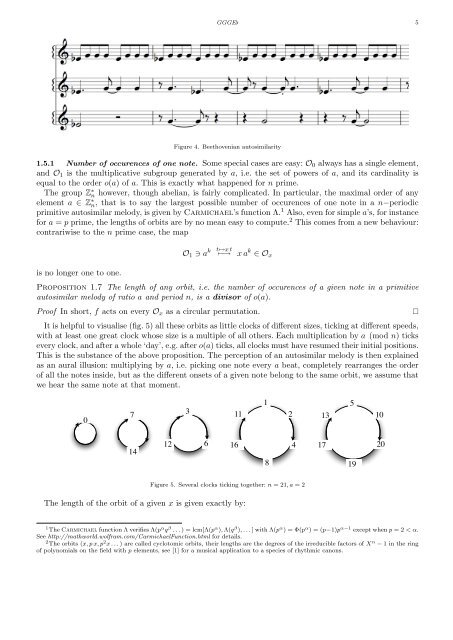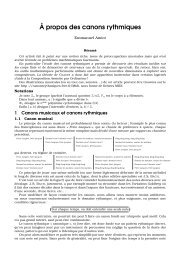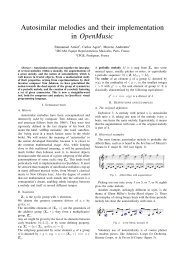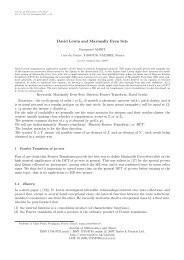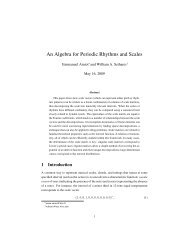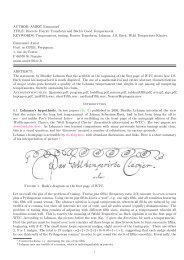Emmanuel Amiot Modèles algébriques et algorithmes pour la ...
Emmanuel Amiot Modèles algébriques et algorithmes pour la ...
Emmanuel Amiot Modèles algébriques et algorithmes pour la ...
Create successful ePaper yourself
Turn your PDF publications into a flip-book with our unique Google optimized e-Paper software.
GGGE♭ 5<br />
Figure 4. Be<strong>et</strong>hovenian autosimi<strong>la</strong>rity<br />
1.5.1 Number of occurences of one note. Some special cases are easy: O0 always has a single element,<br />
and O1 is the multiplicative subgroup generated by a, i.e. the s<strong>et</strong> of powers of a, and its cardinality is<br />
equal to the order o(a) of a. This is exactly what happened for n prime.<br />
The group Z ∗ n however, though abelian, is fairly complicated. In particu<strong>la</strong>r, the maximal order of any<br />
element a ∈ Z ∗ n, that is to say the <strong>la</strong>rgest possible number of occurences of one note in a n−periodic<br />
primitive autosimi<strong>la</strong>r melody, is given by Carmichael’s function Λ. 1 Also, even for simple a’s, for instance<br />
for a = p prime, the lengths of orbits are by no mean easy to compute. 2 This comes from a new behaviour:<br />
contrariwise to the n prime case, the map<br />
is no longer one to one.<br />
O1 ∋ a k t↦→x t<br />
↦−→ x a k ∈ Ox<br />
Proposition 1.7 The length of any orbit, i.e. the number of occurences of a given note in a primitive<br />
autosimi<strong>la</strong>r melody of ratio a and period n, is a divisor of o(a).<br />
Proof In short, f acts on every Ox as a circu<strong>la</strong>r permutation. <br />
It is helpful to visualise (fig. 5) all these orbits as little clocks of different sizes, ticking at different speeds,<br />
with at least one great clock whose size is a multiple of all others. Each multiplication by a (mod n) ticks<br />
every clock, and after a whole ‘day’, e.g. after o(a) ticks, all clocks must have resumed their initial positions.<br />
This is the substance of the above proposition. The perception of an autosimi<strong>la</strong>r melody is then exp<strong>la</strong>ined<br />
as an aural illusion: multiplying by a, i.e. picking one note every a beat, compl<strong>et</strong>ely rearranges the order<br />
of all the notes inside, but as the different ons<strong>et</strong>s of a given note belong to the same orbit, we assume that<br />
we hear the same note at that moment.<br />
0<br />
7<br />
14<br />
12<br />
3<br />
6<br />
11<br />
16<br />
Figure 5. Several clocks ticking tog<strong>et</strong>her: n = 21, a = 2<br />
The length of the orbit of a given x is given exactly by:<br />
1 The Carmichael function Λ verifies Λ(p α q β . . . ) = lcm[Λ(p α ), Λ(q β ), . . . ] with Λ(p α ) = Φ(p α ) = (p−1)p α−1 except when p = 2 < α.<br />
See http://mathworld.wolfram.com/CarmichaelFunction.html for d<strong>et</strong>ails.<br />
2 The orbits (x, p x, p 2 x . . . ) are called cyclotomic orbits, their lengths are the degrees of the irreducible factors of X n − 1 in the ring<br />
of polynomials on the field with p elements, see [1] for a musical application to a species of rhythmic canons.<br />
1<br />
8<br />
2<br />
4<br />
13<br />
17<br />
5<br />
19<br />
10<br />
20


